Mea culpa.
I really cannot blame anyone else. Which is a horrible feeling. I blush at regular intervals thinking about this. Here is my confession:
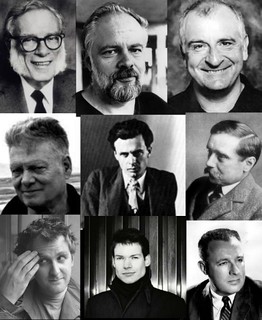
Good authors,
though with some notable commonalities.
1I created a course from scratch. It was all my doing (well, except for the part where I didn't make my students read 50 novels in one semester): I constructed
a syllabus which included ten different authors, all but one of which were white, male, Western and heterosexual (to the best of my knowledge). That's right. I did the
thing.
I have no excuse. There are
reasons of course. Aplenty: It was a tricky syllabus to construct, as it had to consist of a very few books (only 1/4 of the semester's course load), and these books had to be written in English and be particularly useful for the discussion of science fiction in relation to their historical contexts. In addition, I wanted it to serve as an introduction to the field of science fiction studies, which means a sort of "greatest hits" -- because while science fiction is becoming increasingly mainstream I was not at all confident that my students were already science fiction
readers2, and I wanted to show how later books build on earlier ones.
This double aim of the course probably contributed to the lack of diversity. First, because I was so focused on getting the right range in period, focus, reading load and so on, that the question of other kinds of diversity fell off the map. And when that happens, automated categories kick in; and automated categories, in addition to being quite the opposite of critical thinking and therefore rather embarrassing in a scholarly setting, are very bad for diversity: We are socialised into thinking of straight, white men as the default, those who can stand as representatives of all, without limitation to a narrower category. Allow me to explain. (This is nothing new, but it is still not taught in schools as far as I know (hopefully my students will get on that).)
Simone De Beauvoir and Edward Saïd have both discussed the phenomenon, though in two different contexts (gender and orientalism, respectively). The default, be it white, male, middle-class, heterosexual,
cis or able-bodied, remains unmarked (and generally unremarked): It is the norm, and as such does not require specific mentioning (nobody "comes out" as heterosexual, for example; newspapers generally do not mention it when the perpetrator of a crime is white; there are no "men's" sections in newspapers). Women have gender; non-whites have race. And, as I have discussed before,
homosexuality becomes marked as a specifically sexual way of being, so that fairytales where the hero wins a prince are seen as somehow "sexual", while those in which the he wins a princess are not. And from this neutral standpoint, these are given the power to describe and define the others. Moreover, the default is the category that is seen as representative for the whole.
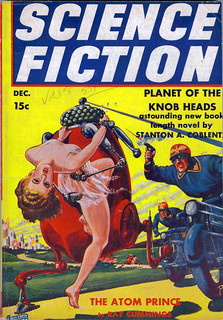
Planet of the knob-heads.
We tend to think in terms of default categories: think "human" (or a subcategory like "author"), and chances are you will think of a white man. And chances are you will think this way even if you are a black woman (if you have grown up in the West). I certainly do, which is why when I went looking for authors who would serve as representatives for their periods, I probably subconsciously went looking for male authors. Because I did not stop to check whether I was being tripped up by ingrained patterns of thinking. Critical thinking requires you stop and check what you are doing from time to time, and when you are tired it is an easy step to skip. (And if you do, you will be kicking yourself and trying to make up for it with the focus of your lectures throughout the semester. Take heed!)
At the same time, my attempt to show how science fiction not only interacts with its own period, but simultaneously with the texts that have preceded it, meant drawing on a canon. Or, in the case of science fiction: two canons (the fan canon and the academic canon, though they sometimes overlap), both predominantly male. Canons have tended to be overwhelmingly male in general (in part because men have been seen as able to speak about the human condition where women have been seen as limited to the feminine), but this has been even more pronounced in science fiction (possibly because technology, exploration and conquest -- the staples of early science fiction -- have been thought of as being a male domain).
3 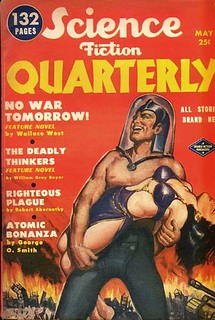
White man saves the day.
Allow me a second digression: When I say that the norm is unmarked, this is not to say that there are not connotations (other terms and labels associated with it) attached to the category. Quite the contrary. The interesting thing is how the same connotations keep cropping up around the norm even when white and male and heterosexual
in themselves have nothing to do with each other. The straight, white man is rational (scientific, and by extension technological), strong, upright, active, conquering &c.
The way in which this is done is by attaching these categories to other binary patterns and separating out its opposites into the category of "the other". This is quite a complex operation, because part of it relies on patterns of binary oppositions, dichotomies, in which one term is valued above the other (our culture is full of them: male/female, mind/body, high/low, white/black, &c., and they tend to go together). The first term is simultaneously valued as neutral and positive, while the second can be simultaneously aberrant, negative and invisible.
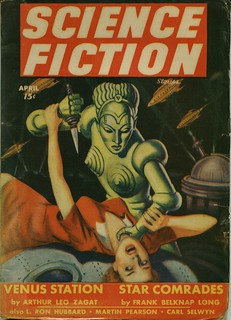
Evil robot monster woman
v
damsel in distress
What complicates matters is that while "the other" is outside the norm, this can be either because they are too good or to bad to be simply normal. Thus, for example, the argument against women having the right to vote stated simultaneously that women were too good for politics and too irrational for it; the oriental can be the wise purveyor of ancient truths and the scheming terrorist or swindler. Sexism, racism, orientalism &c. are not limited to outright negative descriptions of "the other" -- it can be at its most insidious when apparently positive. There are patterns, however: Just as the white male is rational and upright, the female, the (male) homosexual and the (male) oriental tend to be described as frivolous, passive (and simultaneously dangerously aggressive), weak, irrational, mysterious and, tellingly, effeminate (things get more complicated when the categories intersect).
The same structures keep being repeated
ad nauseam, but precisely because they are so ubiquitous, and because they tie themselves so neatly together, they remain invisible unless you know to look for them. We sometimes say that they become "naturalised" (which means that instead of seeing these patterns as something socially constructed, we think of them as natural). And when a genre of literature (returning to science fiction) begins its attempts to constitute itself from its pulpy beginnings, and it does this by defining itself through its focus on science, all these other categories then attach themselves to it (rational, male, white, heterosexual, conquering, Western). And what starts as unacknowledged assumptions become unwritten rules.
The tendency in early science fiction is clear, and while no one could legitimately claim that women were truly absent from the early history of science fiction
4 , they were to a large extent invisible in the magazine period: female characters either absent or unremarkable damsels in distress; female authors hidden behind pseudonyms, initials or gender neutral names. Harlan Ellison famously declared that "
Wilhelm is the woman to beat this year, but Tiptree is the man". As it turns out, James Tiptree, Jr. was really a woman named Alice Sheldon. Likewise, C. L. Moore, Andre Norton, Leigh Brackett, Paul Ashwell, Francis Stevens, C.J. Cherryh... I could go on: all women.
5While there are women in the science fiction genre, however, a canon built from the beginning around the idea of science fiction as male has tended to obscure and discourage them (what we call "erasure").
6 And when I arrived on the scene, setting out to trace science fiction throughout the 20th century, I drew on these male authors. Because that is the dominant tradition, and it is harder to talk about science fiction if you are unaware of their influence. It is a pattern that reinforces itself with every iteration.
My list of sins is not complete. Having included the one woman, I proceeded to make her exemplary of Woman, sexuality and otherness in general (a perfect example of "the Smurfette Principle"). While my lectures turned to otherness in relation to almost every text, the two lectures centred on Le Guin were used to discuss the history of women in science fiction (and I did sneak in James Tiptree, Jr., C. L. Moore, Joanna Russ and Octavia Butler here) and gender. In addition, it was in this context I introduced my students to the concept of patterns of alterity and showed why science fiction is so well suited to exploring it.
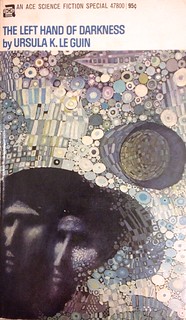
Brilliant!
More so than Le Guin realised.
7This would have been fine if Le Guin had not been the only "other" on the course.
Left Hand of Darkness really is the perfect text for this type of discussion: It not only offers a narrative of first contact, with a narrator fairly close to dominant Western culture of the period; it is first contact with a genderless society, throwing the gendered assumptions of this narrator into high-relief; it is an attempt to imagine a genderless society; and it is perhaps especially interesting in the ways that it fails to do so, as it uses the male pronoun for all the non-gendered characters. It is the perfect book, and it engendered some absolutely beautiful discussions. I would not leave it off the syllabus on any account.
But the effect of focusing on gender in the analysis of the book by the one female author is to perpetuate the idea that gender is a feminine concern, that women writers write books about women's concerns, and that meanwhile male authors write books about other (more universal) stuff (Philip K. Dick writes novels about what it means to be human; Ursula Le Guin imagines a world without gender). Because another aspect of the dynamic of othering is that the other is defined by its otherness (and in turn comes to stand as a representative of that group of others), so that while a white straight man is an individual, the woman is first and foremost a woman, the oriental is oriental and the homosexual homosexual.
8 This is also why, when a black man commits a crime, he comes to stand for his group (think of the black criminal trope). Meanwhile, when young white men go on shooting rampages in schools (frequently primarily targeting women), each incident is dismissed as an aberration (mental illness), rather than a pattern.
By making gender and otherness the focal point of my discussion of the only female writer on the course, I ended up reinforcing the idea that women sf writers, to the extent that they exist, write about "women's things". What you might call
the Jane Austen trap. And by not including any authors outside the default categories, I managed contribute to the erasure of their presence in literary history. And I did all of this
while knowing better.
More or less the moment the course syllabus had gone into print, I realised my error. And I tried to make up for it, of course, by incorporating a discussion of why I had only included one female author (and no black, gay or otherwise "other" authors) on the course (and why that was a problem). But the fact remains that my students did not have to read any. And when they (which they will, because they did love the course) pick science fiction authors to introduce their pupils to the joys of reading English literature, they will most likely pick one of the male authors I introduced them to.
Mea máxima culpa.

The Secret People.
Why am I making such a fuss, kicking myself over this? After all, my students learnt a lot of other stuff, about the development of the genre, about the way in which literature draws on its social and historical context, and they will (hopefully) pass it on to their students in turn. A course cannot do everything in one go, after all. Well, no. But a canon is what we make it, and continuing to highlight people from the same small group of people is supremely unhelpful.
Why is it unhelpful? To start with, because we want more good science fiction writers, and by perpetuating the idea that science fiction writing is done by white, straight men, we teach young black lesbians to find something else to do with their lives.
Representation matters. Likewise, we do not want to keep reinforcing the idea that white, straight men are the ones who get to define the future, to create the patterns according to which we dream and imagine what could be possible.
And finally, this is
science fiction! Science fiction is a genre which at its best keeps trying to make sense of the alien, to confront the human with the non-human and see what happens; it is a genre which uses an unfamiliar setting in order to discuss familiar points at arm's length; and it is frequently a genre which uses both these traits to get delightfully political. Political problems are often invisible if you belong to a privileged group, simply because they do not happen to you. Science fiction writers who fall outside the privileged sections of society are therefore more likely to be aware of such problems and to incorporate them (whether consciously or unconsciously) in their fiction.
As Ursula Le Guin writes in her
"American SF and the Other",
The question involved here is the question of The Other—the being who is different from yourself. This being can be different from you in its sex; or in its annual income; or in its way of speaking and dressing and doing things; or in the color of its skin, or the number of its legs and heads. In other words, there is the sexual Alien, and the social Alien, and the cultural Alien, and finally the racial Alien.
Aside from the matter of representation of the actual categories of people as
people, the figure of the alien comes to embody, to some extent, anxieties about the various others (the not-us). In early science fiction aliens tends to be less than cuddly, serving primarily as something to be conquered, defeated by the (white) (male) hero(es).
Disclaimer: This is not to say that white, straight, Western men cannot write transgressive and interesting science fiction that deals with problems of alterity, gender or sexuality. Theodore Sturgeon wrote
Venus Plus X (1960) and "The World Well Lost" (1953). Stanislaw Lem keeps pushing the boundaries of the alien as the absolute other in
Solaris (1961),
His Master's Voice(1968) and
The Perfect Vacuum (1971).
However, to keep this from happening again, and because it is good for you (and me) to make conscious critical choices about what we read now and again, here is a list of science fiction texts written by people who are somehow "other" to the norm of the white, western, heterosexual man. I would love to get names to add to this list, as this article should have made abundantly clear.
Margaret Atwood.
The Handmaid's Tale. (1985)
-- .
Oryx and Crake. (2003)
Leigh Brackett. "The Citadel of Lost Ships". (1943)
-- .
The Long Tomorrow. (1955)
William S. Burroughs.
The Nova Trilogy. (1961-64)
Octavia Butler.
Lilith's Brood. (1987-98/2000)
-- .
Patternist series. (1976-1984)
-- . "Bloodchild". (1984)
Margaret Cavendish.
The Blazing World. (1666)
C. J. Cherryh.
Downbelow Station. (1981)
Samuel Delany.
Babel-17. (1966)
-- .
The Einstein Intersection. (1967)
-- .
Stars in My Pocket Like Grains of Sand. (1984)
Thomas M. Disch.
334. (1972)
-- .
Camp Concentration. (1968)
W. E. B. Du Bois. "The Comet". (1920)
Kylas Chunder Dutt. "A Journal of Forty-Eight Hours of the Year 1945". (1835)
Suzette Elgin.
Native Tongue. (1984)
Nicola Griffith.
Ammonite. (1992)
Sutton E. Griggs.
Imperium in imperio. (1899)
Nalo Hopkinson.
Midnight Robber. (2000)
Rokeya Sakhaway Hussain. “Sultana's Dream”. (1905)
Kazuo Ishiguro.
Never Let Me Go. (2005)
Gwyneth Jones.
White Queen. (1991)
-- .
North Wind. (1994)
-- .
Phoenix Café. (1997)
Larissa Lai. "Rachel". (2004)
Ursula Le Guin.
The Dispossessed.
-- .
Left Hand of Darkness.
Doris Lessing.
Canopus in Argos series. (1979-83)
Naomi Mitchison.
Memoirs of a Spacewoman. (1962)
C. L. Moore. "No Woman Born". (1944)
-- . "Shambleau". (1933)
Andre Norton.
Star Man's Son, 2250 A.D. (1952)
Nnedi Okorafor.
Lagoon (2014)
Joanna Russ.
The Female Man. (1975)
-- .
We Who Are About To.... (1977)
Mary Doria Russel.
The Sparrow. (1996)
Geoff Ryman. "What We Found". (2011)
-- .
Air: Or, Have Not Have. (2005)
-- .
The Child Garden. (1989)
Mary Shelley.
Frankenstein. Or the Modern Prometheus. (1818)
Vandana Singh.
The Woman Who Thought She Was a Planet and other stories. (2009)
James Tiptree, Jr.
The Girl Who Was Plugged In. (1973)
-- .
10,000 Light-Years from Home (1973)
-- .“The Women Men Don't See” (1973)
-- . “Houston, Houston, Do You Read?” (1976)
Lisa Tuttle. "The Bone Flute". (1982)
Élisabeth Vonarburg.
Le Silence de la Cité. (
The Silent City, 1981)
-- .
Chroniques du Pays des Mères. (
In the Mothers' Land, 1992)
1From top left (with links to sources for photos):
Isaac Asimov,
Philip K. Dick,
Douglas Adams,
Terry Bisson,
Aldous Huxley,
H. G. Wells,
Nick Harkaway,
Hannu Rajaniemi and
Ray Bradbury.
↩2 This turned out to be a good prediction: Only 3 out of about 50 identified themselves as science fiction readers in the first class of the semester -- although a fairly high percentage said we had managed to change that towards the end (which I am counting as a decided win).
↩3 Again, this is a familiar phenomenon, still
going strong in some geek subcultures.
↩ 4 Women wrote a number of utopias, like Mary E. Bradley Lane’s
Mizora: A Prophecy (1880-1) Charlotte Perkins Gilman's
Herland (1915), both of which portray all-women societies. It is interesting to compare these all-women utopias to male narratives of all-male societies. From what I can see, it seems to fit into the norm/other pattern: When men write stories in which all the women are gone, those tend to be societies in which they have excluded undesirable traits associated with femininity from their worlds, narrowing society down to the box marked “male” (e.g. Thomas Gardner’s “The Last Woman” (1932), in which a male “science civilization” (they have an elixir which removes the sexual and emotional distractions in life, providing the perfect scientific society) has only one woman, who is then killed.); when women write all-women stories, this tends to be in order to explore all aspects of what it means to be human -- areas they could not access in contemporary society. I stress that this is very preliminary research from a very specific period, and it should not be taken as an absolute rule.
↩5 I suspect the same is true of other "others", though their particular situations would have been different: homosexuality was still largely illegal, and racial segregation still in effect. And neither would be as closely and clearly tied to names of authors (though I imagine you would find an even clearer erasure of such characters). It would be interesting to read a study of it. It is interesting that a genre so perfectly suited to discussing that which is different (alien) has been so very good at keeping the various categories of "others" out of sight.
↩6 Ian Sales, faced with Isaac Asimov's collection of
100 Great Science Fiction Short Short Storie, in which only five were written by women, compiled
a list of 100 great science fiction short stories by women, which should be taken as a supplement to my list, above.
↩7Le Guin's choice to use the male pronoun, "man" and similar as gender neutral in the story faced a lot of criticism, and while she initially rejected it, she later recanted (See: "Is Gender Necessary?" and "Is Gender Necessary? Redux"). I want it noted, however, that the use of the male pronoun as gender neutral and ignoring homosexuality come together in an interesting mix. The use of the male pronoun becomes so intrusive that it ends up highlighting the thing it generally erases. And while homosexuality is never depicted in the novel, the fact that Estraven is so regularly described as male ends up creating a sort of de facto homosexual love story. I swear, this is the perfect text for teaching alterity.
↩8 I have written about this before, but it bears repeating. This is the reason why an ensemble cast will tend to have one "norm" man in addition to one heterosexual, white & cis woman, one black and/or oriental man, one homosexual man &c. IF they are aiming for diversity (quite often the woman remains as an object of sexual interest while the rest disappear in a puff of invisibility fog, and the selection of other types of men is taken up by the geek, the jock, the business man, &c). Incidentally, it would be interesting to see how often the homosexual male character overlaps with the oriental, since the two categories have historically often been described in similar terms, as effeminate, weak, wily &c. Perhaps I'll get into it when I finally write that intersectionality article I have been promising for a few years now.
↩

Comments